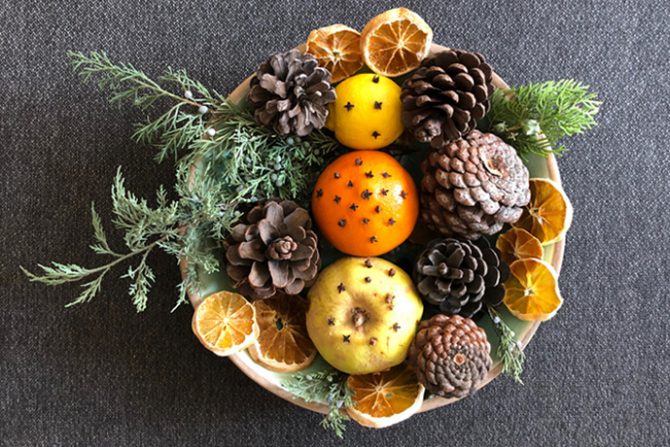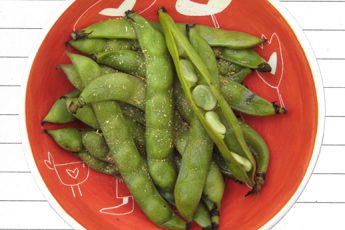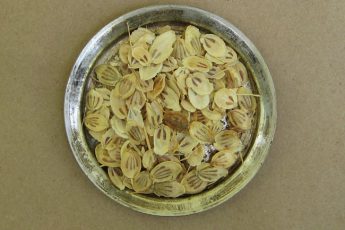Just as I was plump in the middle of writing a blog post listing all the reasons to love bomb the clove spice, I found out about and got distracted by these things made with cloves called pomanders & I couldn’t resist making a detour to write about them first.
An aside. When I first moved to San Francisco (lived there for a few years, loved it) I had such a hard time with the name “Embarcadero” that I kept calling that fabulous waterfront area “abracadabra” for an embarrassing amount of time until the name finally sank in. I’m afraid it’s going to take a while till the name “pomander” sinks in as well. I keep thinking it’s pompadou or pomadore …. insert cringy sweaty emoji here.
OK. What Are Pomanders?
In our modern era, a pomander is simply a citrus fruit, often an orange, pierced by cloves.
Originally, however, a pomander, from the French word pomme d’ambre or “apple of amber,” referred to an ornamental container of perfume, that was worn as a necklace or bracelet or attached to a belt or held as a protective talisman. “The container could be made of gold or silver and eventually evolved to be shaped like nuts, skulls, hearts, books and ships.” (Source)
This very expensive and highly valued jewellery was the present of choice, especially during the Crusades when knights exposed themselves to risks so great that a crucifix alone could not protect them from harm. Pomanders were therefore items for kings, princes, knights and wealthy dignitaries (Source)

Lucrezia de Medici with a bejeweled pomander, an expensive protective talisman for kings, knights & wealthy families accustomed to poisoning each other.
What are Modern-Day Pomanders Used For?
Pomander is a lifehack that can trace its roots to the medieval age. That’s how I like to think of it.
As noted above, in the olden days, pomanders were expensive containers of scent used to guard against infection, to camouflage foul odors, and also as a protective talisman.
The modern-day pomanders are infinitely more humble in their status, aspirations, and scope of purposeful existence:
As the clove-studded fruit dries, the pomander releases a lovely scent. As such they are used to scent a room or are hung (fastened by a ribbon) in a wardrobe to infuse it with fragrance. In addition to being wonderful natural room and closet fresheners, pomanders are also used as Christmas & other holiday decorations and centerpieces. My mother was surprised I’d not noticed this holiday tradition. What can I say, I am a deeply flawed person.
A version of the pomander with oranges, cloves, oils, and a golden ribbon is used as a recovery charm in witchcraft. But oh dear, let’s not get into that.
How to Make Pomanders?
It’s so easy to make modern-day pomanders.
Pierce citrus with the clove spice. Then, pierce your own heart with the rapture of domestic bliss.
In other less rapturous words: grab a firm fruit and a bunch of whole cloves. Stud the fruit with the cloves. Voila, your work is done! See, pomanders are easier than Earth Girls!
- Use your creativity to arrange the cloves in the pattern of your heart’s whimsy.
- If you want to get super fancy and in order to create a pomander with a stronger aroma, cover the entire fruit with cloves, and dust it with aromatic spices of your choice such as ground nutmeg, ground cinnamon, or ground cardamom.
- Lifehack: Instead of directly piercing the fruit with the clove, use a toothpick or needles to make holes. This makes the process of creating clove studs so much easier on your wonderful fingers.
- There is no legislation mandating the pomander fruit has to be citrus. It can be an apple. Or in my case, a quince that I’ve had hanging around my kitchen for a couple of months. Quinces on their own are used as a natural room freshener so I thought, yeah, let’s pierce it with cloves. Why not? My quince now gets to have an adventurous aromatic last chapter of life as a pomander before it’s sadly time to toss it into the bin. I wish I could say till it’s time to toss it into a compost bin but alas I don’t have one.

A more summary pomander arrangement with Persian rosebuds & dried orange slices
How Long do These Spicy Beauties Last?

Clove pierces the citrus for the love of pomander | Behind the scenes peekaboo





We made pomanders at Christmastime all during my childhood. If you put the cloves in tighter together, they will not mold, and they will last for months and months. Cloves are a natural preservative, and the pomanders with the cloves close together will just dry out but still smell really good. Love to see you bringing this back!
Thank you for sharing, Beth!<3 It's a beautiful thing - I'd like to make it a tradition as well. Good to know that if I completely cover it with cloves it will last for months. I may do that with my quince. 🙂
Mother always rolled the fruit in orris root powder, before and after studding them. They keep forever.
Hi Jeanne, I had to look up orris …wow, how intriguing! Thank you so much for sharing.